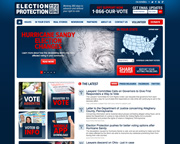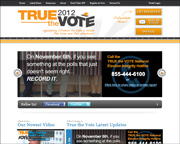Although November 6, 2012
is "Election Day," Election Day has increasingly become a relative
term. More than half of states conduct some form of early
voting.
Early and Absentee Voting A Growing Trend
In the November 2012 general
election, 58.7% of those eligible to vote turned out and 129.1 million
ballots
were cast for president. This was short of the 131.3 million
votes
cast in the race for president in 2008 when 62.3% of those eligible to
vote turned out.
Increasing numbers of Americans are voting before Election Day. According to the U.S. Election Assistance Commission's 2008 Survey (>), 60.2% of those voting in the general election voted in person at polling places, 16.6% voted by domestic absentee ballot, 13.0% by some form of early voting, and 1.3% by provisional ballot. Early voting, which started in Texas in 1991 (>), has now spread to over half the states. (EVIC) Other states allow no excuse absentee voting, and Oregon and Washington are using vote-by-mail. Early voting has significant ramifications on campaigns' get-out-the-vote (GOTV) efforts. Campaigns encourage supporters to vote early (1, 2) as a way of banking votes, so that on Election Day itself they have fewer people to keep track of.
Keeping Our Democracy Running
Smoothly
In 2011-12 much attention focused on voter ID laws (+).
Generally Republicans frame voter ID requirements as a matter of
fighting voter fraud, while Democrats view such laws as a means of
voter suppression. There was a lot of litigation around Voter ID
laws in this election cycle. But voter ID is one of many issues
affecting elections; each year legislatures around the country consider
a range of election-related legislation (>).
More
than
a
decade
after
the Florida debacle and passage of the Help
America Vote Act of 2002 (HAVA) (+) the
possibility
of
incorrect
election
outcomes remains
(>).
Among the areas of concern are shortages of poll
workers (>),
worn
equipment,
issues
with
provisional
and
absentee
ballots,
military
voting
and
overseas
voting.
In
July
2012
the
Verified
Voting
Foundation,
Common
Cause
and
the
Rutgers
Law
School
Constitutional
Litigation
Clinic
released an
in-depth survey of states' voting equipment which noted "it is highly
likely that voting systems will fail in multiple places across the
country (>)." Laws
themselves don't solve problems; they must be interpreted and
implemented, sometimes under trying conditions as happened with
Hurricane Sandy (1, 2).
Directives and rulings by secretaries of state
or election officials may provoke controversy (+).
Finally, on the frontlines are the nation's election administrators (Election Center), who must
work to
keep their practices and technology up-to-date and to implement new
ideas to improve the voting process in their jurisdictions. The
U.S.
Election Assistance Commission (EAC),
formed as a result of HAVA, serves as a national clearinghouse for
administrators, but has been without
commissioners since Dec. 2011, and some in Congress have sought to
defund it.
On
Election
Day
itself and
in
the
days
leading
up to it, partisan and independent
observers, federal observers, and international observers of varying
stripes mobilize to ensure that voters' rights are protected and their
intentions heard (1, 2, 3, 4[PDF],
5)
also see
from 2008: 1,
2,
3,
4,
5).
Election Night: Unofficial Results, Exit Polls...Showtime
Election night coverage and the multi-page spreads in the newspaper the next morning are the culmination of months of preparation and planning.
One key component of election coverage is exit polls, which
are based on surveys of
voters in randomly selected precincts as they leave polling
places. Exit polls provide a window on the concerns of voters and
useful information on variations in voting behavior by gender, race,
age, education, income and other factors. From 1988 to 2002 exit
polls were overseen by Voter News Service (initially called Voter
Research and Surveys), an entity formed by the
networks and the Associated Press. After poor performance in the
2000 and 2002 general elections, the partners disbanded VNS, and a new
cooperative, the National Election Pool,
comprised of ABC News, CBS News, CNN, FOX News, NBC News and the
Associated Press, formed. Edison
Research (formerly Edison
Mitofsky) has conducted all exit polling for the National Election Pool
since the 2004 general election. Edison reported in a Nov. 13,
2012 blog posting:
"The U.S. election exit polling effort is the largest single-day survey research project in the world. The national exit poll survey includes 26,565 interviews with voters in all 50 states and the District of Columbia. The interviews were conducted at 350 polling locations on election day, along with 4,408 telephone interviews of absentee and early voters. In addition, Edison staffers collected over 90,000 additional interviews across the country to provide election analysis of dozens of state-level elections. In total, over 3,000 Edison staff members collected nearly 120,000 interviews, all within the span of 16 hours."
A second important element of election night coverage is the
collection, tabulation and
distribution unofficial election night vote results for
presidential, Senate, House and gubernatorial races. The
Associated Press fulfils this role. As described in a 2008 press
release:
"The more than 500 AP reporters, editors, videographers, technical support personnel and other staffers involved in covering the presidential, congressional and state elections and counting the votes will be joined and assisted on Nov. 4 by an army of 4,600 local reporters, known as stringers, who will fan out across the country to collect vote results from county clerks and phone them into four regional election tabulation centers -- two in Spokane, Wash., a third at AP headquarters in Manhattan and a fourth in Brooklyn."
For news organizations, when everything works, election night is as
good as it gets, a chance
to show what they can do. Anchors man elaborate sets,
correspondents around the country file reports, and, as the evening
progresses, states are called one way or another and the map begins to
fill in with red and blue.
[News
Organizations
Cover
Election
Day
2012]
After last-ditch campaign
swings, the candidates head to their home states. Typically on
the morning
of Election Day they vote, and photos and video of those scenes go out
to the world. (This cycle President Obama voted early, on
October 25, 2012, to emphasize the importance his campaign is placing
on early voting) (+).
The candidate may squeeze in a few more campaign
events, as Romney and Ryan did, then prepare for the last speech of the
campaign, be it victory
or
concession. Because the
race
appeared
to
be
dead
even, there were suggestions that
the outcome might not be known on Election Day; one worst case scenario
posited that it might be necessary to wait for the counting of
provisional ballots in Ohio. The evening of November 6, 2012 did
not drag on as long as many had expected. NBC News was first to
call Ohio and the race at 11:12 p.m. EST (after the 8 p.m. (11 p.m.
EST) West Coast poll closings); CBS News, FOX News, CNN, and ABC News
followed. It was after midnight when former Gov. Romney, in
Boston, called President Obama and then delivered his concession
speech. Obama made his victory
speech shortly thereafter in Chicago.
The Morning After...What Does It Mean?
The days after the
election are peak season for pundits as they assess, analyze, discuss
and debate the meaning of the results. Various interest groups
offer their own post-election assessments, often using the opportunity
to point to the impact their constituency had on the outcome and to
stress their key issues.
[Reactions
2012, 2008,
2004]
129.1 million votes
were tallied in the race for president, the second most ever after
2008. Obama
garnered 65.9 million votes (51.0%)
to 60.9 million (47.2%) for Romney. Libertarian Gary Johnson received
1.3 million votes (just below 1.0%), Green Jill Stein less than half a
million votes (0.36%) and other
candidates accounted for the remaining 0.45% of the vote. Obama
carried 26 states and
the District of Columbia, winning 332
electoral votes to 206 for McCain.
Details
[See also: David Leip's Atlas of U.S.
Presidential Elections, Federal
Election Commission, Mark
Newman-cartograms]
| Year | Voting Eligible Population | Highest Office | Total Turnout | Highest
Office Turnout Rate |
Total Ballots Counted Turnout Rate |
| 2012 |
221,925,820 |
129,072,347 |
130,306,739 |
58.2 |
58.7 |
| 2008 |
212,720,027 | 131,304,731 | 132,588,514 | 61.7 |
62.3 |
| 2004 | 203,483,455 | 122,294,978 | 123,535,883 |
60.1 | 60.7 |
| 2000 | 194,331,436 | 105,375,486 | 107,390,107 |
54.2 | 55.3 |
| 1996 | 186,347,044 | 96,262,935 | - |
51.7 | - |
| 1992 | 179,675,523 | 104,405,155 | - |
58.1 | - |
| 1988 | 173,579,281 | 91,594,691 | - |
52.8 | - |
| 1984 | 167,701,904 | 92,652,680 | - |
55.2 | - |
| 1980 | 155,635,102 | 86,515,221 | - |
54.2 | - |
Source: United States
Elections Project at George Mason University. Use of voting
eligible population is a refinement on the old measures which used
voting age population. Advanced by Dr. Michael McDonald at George
Mason,
the concept removes non-citizens and ineligible felons from the
equation. See also Center
for the Study of
the American Electorate at American University.
Each election is unique and produces a set of lessons
and areas that
need improvement. Long lines at polling place in
some jurisdictions emerged as a signature
problem of the 2012 general election. In his Inaugural Address,
President Obama declared, "Our journey is not complete until no citizen
is forced to wait for
hours to exercise the right to vote." Obama announced on March
28,
2013 the
establishment of a Presidential Commission on Election Administration [PDF], +;
it is due to issue a
report six months after its first meeting (+, see
also GAO report >).
Individual states and
localities are moving to make improvements as well (examples 1, 2, 3). The
Election Assistance Commission, although hampered by a lack of
commissioners, is preparing a 2012 Election Administration and Voting
Survey which should offer useful insights as well.
Election Day: Take 2...The Electoral College
As you will recall from high school, the president is not selected by direct popular vote, but by intermediaries known as electors. The electoral system is outlined in the Twelfth Amendment to the Constitution, adopted in 1804 (this significantly modified the original provisions contained in Article II). Each state has a number of electors equal to its number of congressmen and Senators. The District of Columbia has three electors, bringing the total to 538. Most states use a winner-take-all rule; all the state's electors go to the winner of the popular vote in the state. The exceptions are Maine and Nebraska, which distribute the electors by congressional district.
Electors are generally party activists. Some months before the election each party puts together a slate of electors, chosen by congressional district with the exception of the two at-large Senate slots. If the party's presidential candidate wins the popular vote in the state on Election Day, the members of his or her slate are officially appointed as electors; if not they stay home.
The law governing electors and the counting of the electoral votes is 3 U.S.C.§§1-21. Electors meet in ceremonies in each of the state capitols and in the District of Columbia on the first Monday after the second Wednesday in December (December 17, 2012). The electors sign the certificates of vote--actually they sign six copies of the document so there are back-ups. There are separate votes for president and for vice president. Each state sends one copy of the certificate of vote to the Office of the President of the United States Senate.
On January 4, 2013 in a special joint session of Congress
these envelopes were opened and
tallied and the re-election of Barack Obama and Joe Biden
certified. (The designated day, January 6, fell on a Sunday so on
January 3 Congress passed a resolution changing the date >).
Normally this is a pro forma exercise, but there have
been exceptions. In 2001 members of the Congressional Black
Caucus tried to get Congress to reject Florida's
electors, but they could not find a Senator to support their
effort. In 2005 certification of the state results proceeded
alphabetically until the Ohio votes were announced. At that point
Rep. Stephanie Tubbs-Jones (D-OH), supported by Sen. Barbara Boxer
(D-CA), announced a
challenge. Debate followed, but the election of President Bush
and Vice President Cheney was finally and officially certified.
Despite Critics Electoral College
Likely to Endure for Years to Come
Over the years there have been many efforts to abolish
the Electoral
College and establish direct popular vote; each Congress
several resolutions are introduced, but none of them has made
headway. Additionally there have been attempts in a number of
states to move away from winner-take-all distribution of
electors. In 2004
Colorado voters rejected an initiative which would have distributed
electors proportionally according to popular vote in the state.
More recently Republicans have sought to alter
allocation of electors in several big states that typically have
supported the Democratic candidate for president. In Sept. 2011
Pennsylvania Senate Majority Leader Dominic Pileggi (R) introduced SB
1282, a proposal to allocate electors by congressional district (+). A similar bill
was introduced in Wisconsin. Following
the 2012 election, Virginia State Sen. Charles “Bill”
Carrico Sr. (R) introduced a bill which would have awarded electors to
the winner in each
of the commonwealth's congressional districts and awarded the remaining
two to the winner of
the most congressional districts; this died in committee. In
Pennsylvania, Pillegi introduced a new bill on Feb. 21, 2013, this time
proposing to allocate electors proportionately according to the popular
vote (SB 538) (+),
and there has been activity in several other states.
In 2006 a
group called National
Popular Vote launched an effort to bring about change through the
state legislatures. The premise is a compact or "Agreement
Among the States to Elect the President by National Popular Vote" which
would take effect once states totalling 270 electoral votes have
enacted it. In August 2010 Massachusetts became the sixth state
to enact the measure, and in October 2010 the District of Columbia
approved the bill taking the agreement to 28% of the needed
amount. The National Popular Vote effort is ongoing, but at its
current pace it is clear that the Electoral
College system will still be in place for the forseeable future.
Election
Integrity
 |
 |
 |
| Verified Voting Foundation, Inc. | Election Protection |
True the Vote |
Developments
and
Trends
electionline.org
U.S. Election Assistance Commission
Early Voting Information Center
Election Center
National
Conference
of
State
Legislatures:
Election
Laws & Procedures
Election Law Blog
Changing the
Process to Increase Participation
Brennan
Center
for
Justice:
Voting
Rights
and
Elections
Why Tuesday?
Electoral College
Electoral
College (National Archives site)
National Popular Vote
FairVote. "Presidential
Election
Inequality:
The
Electoral
College
in
the
21st
Century." (Feb.
2006)
General
American National Election
Studies (ANES)
Edison Research

